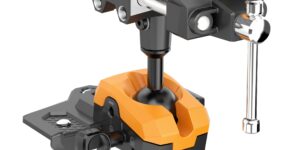Machine Rebuilding vs. Remanufacturing
A review of the basics when considering a machine retrofit, rebuild or remanufacture.
Posted: February 7, 2008
In machine rebuilding, different terms can mean different things depending on the company. Generally, the term “retrofit” entails all things electronic, a rebuild all things mechanical; and remanufacturing involves a combination of both, with some additional engineering upgrades, and can take considerable effort and time, months in some cases.
This month, Fabricating & Metalworking talks with Scott Ashworth, president of KRC Machine Tools Services (Independence, KY) about the ins and outs of machine-tool remanufacturing.
F&M: When considering a rebuild, where should a company start?
Scott Ashworth: From the start, the first question should be: Do you put money into retrofitting, rebuilding, or remanufacturing, or do you simply discard the equipment and invest in new technology?
Price, of course, is always a factor, but it isn’t always the dominant factor. Technology and capability are important. There are some older machines out there that just can’t be run at high speeds. Some have integral design elements that won’t allow some of the features that the new machines have.
When end-users make the determination [to retrofit, rebuild or remanufacture], they really need to determine what feature they need out of their machine tool. If their desired processes mean five times faster rpm, three-time faster feed rates and 10 times faster tool changes, a remanufacturing solution may not work.
Many attempt to remanufacture an old machine; it’s a good machine tool, and it’s been a good machine tool that has fit their processes for years. Yes, they could gain some benefits by pushing it faster or making it more accurate, but does it fit the operation? For some, just getting the machine back to the way it was the day they bought it will suffice.
With today’s price of new machine tools, remanufacturing has focused on the big, old iron-the large machine tools. It’s simple economics; the larger the machine tool, the harder it is to replace. That’s why we focus on the 1,000-mm machine, the 48-inch vertical boring mills and up.
Though there are exceptions, of course, in remanufacturing the best bang for the buck is with larger machining centers.
F&M: What can happen if a company requests less than what it needs for their productivity goals?
Ashworth: Times haven’t changed; many try to get something done for nothing, and often a request for a machine rebuild may not include items necessary to meet the long-term production goals of a company. We will always quote a project, but we do include "recommended price options" that, in essence, say "You will most likely need to address this, and without it you may not be able to meet your manufacturing requirements, be it positioning accuracies, control options, etc."
We do menu-type quotes, but the base quote does include a minimum of what we feel will ensure the machine will perform to standards. Sometimes we do have to walk away from a job if we’re asked to do too little. Though the rebuild solution may give some short-term gains, it can ultimately turn around and become a permanent loss for a customer.
The bottom line: An incomplete rebuild can leave you worse off than where you were before. Even with just a control retrofit, don’t just hang the control on there, using the existing servos, drives and the existing wiring. True, with some jobs it’s a viable option, but for many it’s not; it can open yourself up to a whole world of problems.
F&M: How does documentation enter the picture?
Ashworth: This is one of the most important things for a company to look at. First, I feel it shouldn’t be copyright protected, and there shouldn’t be limits to how many copies you can make. Any documentation you get from a rebuilder should be electronic, free to be copied and shared.
Second, it should be complete, with everything a professional would need to service the machine. This includes the ladder logic. The logic is no good to you to troubleshoot with if it isn’t fully labeled and cross-referenced-and that includes every coil, every rung, every contact in that ladder. Without this, it makes it virtually impossible to troubleshoot. What if a tool change stops? Because you wouldn’t know if one coil or contact is open, because nothing is labeled, you can’t know what is stopping that tool change. (Note that to edit that logic will require OEM software, from GE Fanuc, Siemens or otherwise. When you do receive the ladder logic, ensure that it can be viewed on the controller screen.)
F&M: Are there any telltale signs for company management to look for that shows them it’s time to take a look at their machinery situation?
Ashworth: We had a three-year contract with an aerospace company that needed to upgrade 30 machines. The impetus for this work came when the company realized what their maintenance technicians were doing to keep the machines operating. They were working on motherboards, drives, motors, all this component-level stuff. Why? Because of the machines’ age, there were no replacements to be had.
One of the biggest costs of any facility is labor. When you have highly skilled electronics technicians on staff dong troubleshooting of motherboards and other component-level elements, it’s ludicrous.
For the office environment, how many IT techs troubleshoot down to the component-level? In reality, they don’t. They take the motherboard out, throw it away and put in a new one.
When parts aren’t available, that’s a telltale sign to upgrade or buy new, whichever makes more business sense.
F&M: Where do you see remanufacturing in three to five years?
Ashworth: We saw a big upturn in the control retrofit arena two decades ago, and for good reason. In the late 80’s and early 90s, CNCs became extremely reliable, almost bulletproof.
A decade ago we we’re seeing more and more mechanical-only rebuilds. Machines were pushed harder and harder. Mechanically, machines just wear out faster than they used to. They may not be quite as strong as the old machines with a cast-iron bed, but they are still made very, very well. It’s more about uptime: machines run faster and longer, three shifts a day, five days a week given the reliability of the controls.
Today we are starting to see it turn around again because some of the first generation high powered CNC controls, motors and drives are showing their age and lack of technology. We have actually been asked to retrofit machines that we retrofitted 15 years ago. Sometimes it is due to wanting and needing the expanded features of the newer control systems and sometimes it’s due to lack of support on the hardware. Either way it looks like retrofitting is on the upswing again.
The old cast-iron machine beds have their advantages; they last decades. The machine can be rebuilt two or three times and still be an excellent-quality machine tool. When you look at those vintage machines, they’re beefier and they take a pounding. But again, it needs to match your process-and high speed can’t be part of the equation. We rebuild a 1960s Meehanite casting machine with box ways; we got 200 to 300 inches per minute out of it, and that’s all we’re going to get. Now look at a new machine running 1,100 ipm with a 15,000-rpm spindle. There’s no comparison. If you don’t need that speed and advanced technology, then the "old iron" vintage machine might fit your needs for years to come.
Editor’s Note: Artwork courtesy of KRC Machine Tool Services, www.krcmachinetoolservices.com









